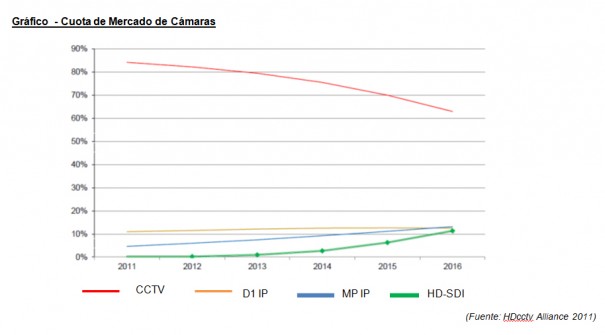¿Cuáles han sido los últimos adelantos en CCTV?
El Circuito Cerrado de Televisión (CCTV) ha sido uno de los pilares de los sistemas de seguridad durante décadas. Gerardo Cuervo Chávez, responsable de Networking de Lilin, fabricante de soluciones de video IP y CCTV tradicional para clientes profesionales, asegura en este artículo que los sistemas de seguridad CCTV apuestan cada vez más por la tecnología IP y HD-SDI, que tienen ventajas significativas en comparación con los sistemas analógicos tradicionales.
El Circuito Cerrado de Televisión (CCTV) es un sistema de transmisión de imágenes compuesto, básicamente, por un número determinado de cámaras y monitores, en el cual se transmiten señales desde las cámaras a los monitores, but, ¿cómo han mejorado estos dispositivos para adaptarse a los mercados en los últimos años?
Hasta hace muy poco, las tecnologías disponibles para CCTV se limitaban a dos: CCTV analógico o IP. Para las aplicaciones en donde no se requiere alta definición pero sí se requiere mantener el bajo coste, la opción de CCTV analógico es —y por un buen tiempo, será— la solución más adecuada y elegida por el mercado. Instead, al necesitar de mayor definición los usuarios optan por abandonar el CCTV analógico (cuya definición, por cierto, está limitada a los viejos estándares de TV PAL/NTSC) y elegir el equipamiento IP. Si bien al utilizar redes de transmisión de datos los equipos IP no tienen limitación en cuanto a la calidad de imagen, en los últimos tiempos el mercado ha notado ciertos problemas a la hora de ejecutar un proyecto con tecnología IP.
Estos problemas se deben a la compresión/codificación – transmisión – descompresión/decodificación de la imagen, procesos que reducen la calidad de la imagen inicial, sumando un pequeño retardo en la transmisión desde que fue capturada por la cámara hasta que es visualizada en el puesto de monitoreo.
Si la instalación no ha sido diseñada y ejecutada cuidadosamente, algunos cuellos de botella en la red y falta de recursos de software/hardware en la decodificación pueden hacer que el retardo de transmisión de la imagen sea aún mayor. Estos inconvenientes son los más acusados por los usuarios y producen una cierta insatisfacción, especialmente cuando el monitoreo en tiempo real es importante. Es aquí donde el nuevo estándar HD-SDI puede marcar la diferencia, haciendo interesante su aplicación en lugares tales como casinos, airports, seguridad urbana, bancos y otros sitios con altas exigencias.
¿Qué es el HD-SDI?
Tal como sugieren sus iniciales (High Definition Serial Digital Interfase) es un estándar para transmisión de alta definición, basado en una interfaz de datos serie. Estos datos serie viajan por un único conductor (cable coaxial o fibra) a una tasa cercana a los 1.485Gb/s, y se usan para transmitir video digital sin codificar ni comprimir. En caso de usar un cable coaxial se puede extender la conexión hasta los 300 m, siempre y cuando el cable sea de buena calidad.
Dado que la imagen se transmite sin comprimir ni codificar, se cuenta con la más alta calidad que permita el formato y no se agrega ningún retardo adicional. Este estándar es actualmente utilizado en broadcasting (producers, editoras y canales transmisores de TV en HD) y con ello su éxito como medio de alta definición que está ya debidamente probado. A raíz de esto, como ventaja adicional a la hora de aplicarse en CCTV, es que se pueden utilizar CCD y otros componentes que en la actualidad ya se usan en broadcasting, cuyas pretensiones de calidad, definición, estabilidad y durabilidad son extremas.
Aplicación y futuro del HD-SDI en CCTV
Si bien los sistemas de monitoreo basados en HD-SDI tienen obvias ventajas, todavía hay ciertos aspectos negativos que deben resolverse. For example, la conexión de dispositivos a grandes distancias (por coaxial, limitada a 300 m en el mejor de los casos, salvo que se utilice fibra óptica), la necesidad de mayor capacidad de almacenamiento del video, la falta de popularidad de los equipos en HD-SDI y el hecho de que no se producen en cantidades importantes hacen que los costos de los mismos sean muy elevados por el momento. Besides, existen necesidades especiales en donde la definición requerida es mayor a la que puede manejar un dispositivo HD-SDI (en la actualidad, 720p y 1080p).
Con el tiempo seguramente más fabricantes podrán ofrecer más variedad de equipos en HD-SDI. Y si las cantidades de producción lo permiten bajarán los costes de los dispositivos, haciendo viable esta tecnología en aplicaciones de menor presupuesto.
Hoy en día, la tecnología IP es uno de los principales aliados en materia de videovigilancia y cada vez más empresas están tendiendo a instalar este tipo de soluciones. But, ¿a qué se debe este fenómeno?
• Digitalización
El sistema IP utilizado para CCTV está compuesto por cámaras que permiten obtener mejores resoluciones y mayor calidad de imagen que los sistemas analógicos, posibilitando así un fácil y rápido reconocimiento de incidentes, control de accesos, incendios, entre otros eventos. This, sumado a la flexibilidad que da la forma de transmisión de los datos, el poder enviar por un cable UTP, por fibra o por un enlace inalámbrico, hace que prácticamente se puedan utilizar para cualquier necesidad que se presente en el mercado.
• Almacenamiento
Las cámaras tienen sistemas de configuración, administración y grabación de video. Además poseen funciones inteligentes como búsqueda de eventos, detección de movimiento, detección facial, detección de audio, detección anti-sabotaje, envíos de correo electrónico como notificación de alarmas, entre otras funciones avanzadas como las que incluyen las cámaras iMegapro. La grabación se realiza en el disco duro, la captura de imagen es sencilla, su calidad consistente y permite acceder a los videos a través de las redes IP, lo que garantiza una fidelidad mayor de la que otro sistema pueda ofrecer.
• Integración
Los sistemas de Circuito Cerrado de TV permiten incorporar múltiples dispositivos adicionales al sistema inicialmente instalado para ampliar el almacenamiento de las imágenes. La instalación e integración de múltiples equipamientos permite garantizar un control efectivo y verificación de la instalación de video vigilancia. Los sistemas IP no sólo son integrables con otras tecnologías, sino que también posibilitan el acceso remoto a todos los registros desde una misma pantalla.
• Economía
Contrariamente a lo que se cree, las instalaciones de sistemas IP son más económicas ya que los gastos extras de cableado que consume son menores y, esencialmente, porque permite la utilización de redes inalámbricas. Economizando no sólo los costes de cableado, sino también los costes de instalación y su mantenimiento.
• Nuevas tendencias del mercado
Las nuevas tendencias también llevan al mercado a optar por equipos HD que brindan vista panorámica y desde distintas perspectivas sobre escenas en vivo o grabadas; todo en alta definición.
 Según datos de la alianza HDcctv, según la previsión hasta el 2016 -como podemos ver representado en el gráfico- la cuota de mercado de cámaras analógicas se verá seriamente perjudicada con una pérdida de hasta un 20% de cuota de mercado en ventas y sin embargo nuevos productos como cámaras megapixel y cámaras HD-SDI crecen hasta un 10% de cuota de mercado. Las nuevas tecnologías megapixel ofrecen más resolución y calidad de imagen, por lo que tiende a crecer con fuerza en cuota de mercado y las convencionales, analógicas, pierden mercado a pasos muy rápidos.
Según datos de la alianza HDcctv, según la previsión hasta el 2016 -como podemos ver representado en el gráfico- la cuota de mercado de cámaras analógicas se verá seriamente perjudicada con una pérdida de hasta un 20% de cuota de mercado en ventas y sin embargo nuevos productos como cámaras megapixel y cámaras HD-SDI crecen hasta un 10% de cuota de mercado. Las nuevas tecnologías megapixel ofrecen más resolución y calidad de imagen, por lo que tiende a crecer con fuerza en cuota de mercado y las convencionales, analógicas, pierden mercado a pasos muy rápidos.
Gerardo Cuervo Chávez
Responsable de Networking de Lilin Spain
Did you like this article?
Subscribe to our NEWSLETTER and you won't miss anything.




